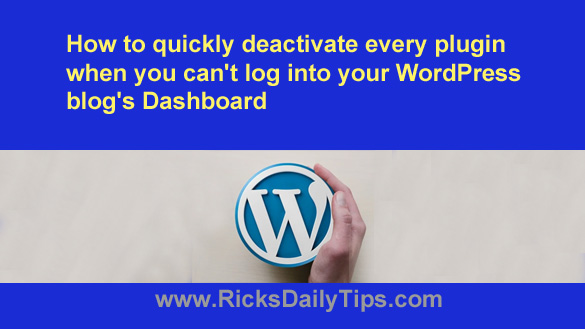 In my opinion, WordPress is the most powerful blogging platform out there. And truth be told, it’s also one of the easiest to use.
In my opinion, WordPress is the most powerful blogging platform out there. And truth be told, it’s also one of the easiest to use.
There are times however when something goes wrong and your blog simply refuses to load in a web browser.
If you’re new to WordPress it can be quite frightening the first time you see the dreaded “white screen of death” – the stark, solid white error page that WordPress displays when it encounters what it deems to be a catastrophic error.
I know how easy it is to panic when your blog won’t load, and that dreadful feeling is even more intense when you can’t even log into your WordPress Dashboard.
There are a number of things to check when troubleshooting “white screen” issues, but the first thing I always do when I don’t have a clue what’s causing an issue is to deactivate all the plugins at once to see if the problem goes away.
If it does, that tells me that a faulty or incompatible plugin is causing the problem.
I then reactivate the plugins one-by-one until the issue arises once again. At that point I know which plugin is the culprit (it’s the one I reactivated just before the problem returned).
Well, all of that is well and good, but what if your issue prevents you from even being able to log into WP-Admin
After all, if you can’t log in to your blog’s Dashboard you’ll have no way to disable all the plugins as I mentioned above.
Luckily, there’s a very easy way to deactivate all of your blog’s installed plugins in one fell swoop even when you can’t access the WordPress Dashboard.
All you have to do is use an FTP program to rename your blog’s plugins folder to something else. Here’s how:
Note: If your web server’s control panel allows you to access your blog’s files at the server level (and it probably does) you can use its File Manager utility instead of an FTP program to rename the plugins folder.
Just start following the instructions below at step 4, substituting your control panel’s File Manager utility for the FTP program.
1 – If you don’t have one already you’ll need to download, install and configure a free FTP client to give you access to your blog’s WordPress files (on the blog’s web server, not your local computer).
There are several excellent free FTP clients to choose from, but I really like FTP Commander and FileZilla.
3 – Once you have your chosen FTP client installed, follow the instructions on their website to configure it to log in to your blog’s web server.
4 – Use your FTP client to login to your blog’s server, then navigate to your WordPress installation’s plugin directory.
The actual path to your blog’s plugin directory will depend on your server setup and how your blog is configured, but it should be a sub-directory under the wp-content directory. In other words, navigate to the wp-content directory and you should see the plugins directory listed there.
5 – Once your FTP client is pointing to the wp-content directory, simply right-click on the plugins folder and rename it. I always just append the extension .bak to the word plugins to give me plugins.bak, but you can use any temporary name you want.
After you have renamed the plugins folder your blog should immediately be accessible if a faulty or incompatible plugin is what was keeping your blog from loading.
6 – If you in fact determine that you have a plugin issue, double-click on the newly-renamed plugins folder to open it, then use the same method you used to rename the plugins folder in step 5 above to rename the folders for each of your installed plugins.
7 – Navigate back to the wp-content folder and rename the plugins folder back to plugins.
8 – Double-click on the plugins folder once again, then rename the first plugin in the list back to its original name and check to see if your blog still loads.
If your blog now fails to load, that plugin has to be causing your blog’s “white screen” issue.
If that’s the case, simply delete that plugin’s folder to effectively uninstall the bad plugin and your blog will be back up and running after you rename all the remaining plugins back to their original names.
Note: At this point you can either try re-installing the plugin you just removed to see if a corrupted file was causing the problem or find a different plugin that provides the same functionality. Alternatively, you can simply stop right there and use your blog without the feature that was being provided by the deleted plugin.
9 – If the first plugin you renamed wasn’t the one causing the problem, repeat step 8 above until you find the guilty plugin.
That’s all there is to it. Now you know how to troubleshoot a “white screen” issue that’s being caused by a faulty or incompatible WordPress plugin.
Of course there are other issues that can cause your blog to display the dreaded “white screen of death”, but my own experience suggests that you’ll find a bad plugin to be the culprit if the white screen appeared immediately after installing a new plugin or updating an existing one.
Bonus tip: This post provides 9 tips to prevent your WordPress blog from getting hacked.